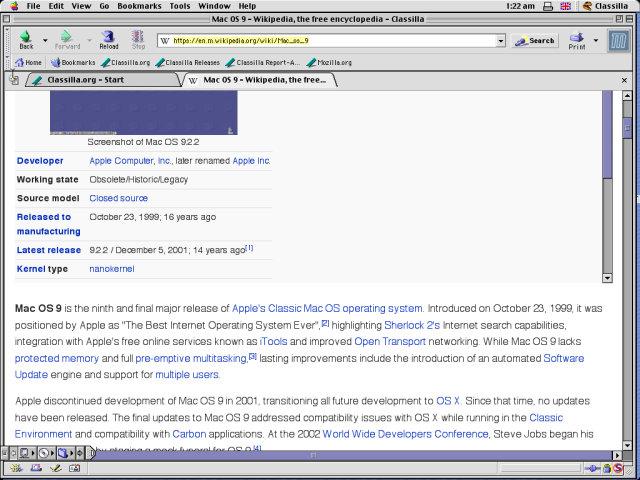
- #MAC OS 8.6 INTEGRATED DEVELOPMENT ENVIRONMENT MAC OS X#
- #MAC OS 8.6 INTEGRATED DEVELOPMENT ENVIRONMENT MAC OS#
- #MAC OS 8.6 INTEGRATED DEVELOPMENT ENVIRONMENT FULL#
- #MAC OS 8.6 INTEGRATED DEVELOPMENT ENVIRONMENT SOFTWARE#
- #MAC OS 8.6 INTEGRATED DEVELOPMENT ENVIRONMENT SERIES#

#MAC OS 8.6 INTEGRATED DEVELOPMENT ENVIRONMENT MAC OS#
Other features introduced in Mac OS 8.0 include the following: Major changes in this version included the Platinum theme, a Finder which was PowerPC-native and multithreaded, and greater customization of the user interface.
#MAC OS 8.6 INTEGRATED DEVELOPMENT ENVIRONMENT SOFTWARE#
The software was renamed Mac OS 8 before final release. (after being introduced a few days earlier on July 22 ) The early beta releases of the product which were circulated to developers and Apple internal audiences, were branded as Mac OS 7.7, superseding the then-current release, Mac OS 7.6.
#MAC OS 8.6 INTEGRATED DEVELOPMENT ENVIRONMENT MAC OS X#
This ultimately led to Apple buying NeXT and developing Rhapsody which would eventually evolve into Mac OS X in 2001 (now named macOS).ĭeveloped under the codename "Tempo", Mac OS 8.0 was released on July 26, 1997. In August 1996, Apple chief technology officer Ellen Hancock froze development of Copland and Apple began a search for an operating system developed outside the company. Mac OS 8.0, released six months later, continued to integrate Copland technologies into the Mac OS. These updates began with Mac OS 7.6, released during WWDC. At the Worldwide Developers Conference in January 1997, Apple chief executive officer (CEO) Gil Amelio announced that, rather than release Copland as one monolithic release, Copland features would be phased into the Mac OS following a six-month release cycle. With a dedicated team of 500 software engineers and an annual budget of $250 million, Apple executives began to grow impatient with the project continually falling behind schedule. The release date was first pushed back to the end of 1995, then to mid-1996, late 1996, and finally to the end of 1997. The Copland development was hampered by many missed deadlines.
#MAC OS 8.6 INTEGRATED DEVELOPMENT ENVIRONMENT FULL#
The system was intended to be a full rewrite of the Mac OS, and Apple hoped to beat Microsoft Windows 95 to market with a development cycle of only one year. Copland was to be followed by Gershwin, which promised memory protection spaces and full preemptive multitasking. Apple intended Copland as a fully modern system, including native PowerPC code, intelligent agents, a microkernel, a customizable interface named Appearance Manager, a hardware abstraction layer, and a relational database integrated into the Finder. It was announced in March 1994 alongside the introduction of the first PowerPC Macs. Starting in 1988, Apple's next-generation operating system, which it originally envisioned to be "System 8" was codenamed Copland. Its successor, Mac OS 9, was released on October 23, 1999.

It features PowerPC native versions of QuickDraw, AppleScript, and the Sherlock search utility. Mac OS 8.5 is the first version of the Mac OS to require a PowerPC processor. Mac OS 8.1 introduces a new, more efficient file system named HFS Plus. Mac OS 8.0 introduces the most visible changes in the lineup, including the Platinum interface and a native PowerPC multithreaded Finder. As it came at a difficult time in Apple's history, many pirate groups refused to traffic in the new OS, encouraging people to buy it instead. Mac OS 8 is one of Apple's most commercially successful software releases, selling over 1.2 million copies in the first two weeks. Mac OS 8 helped modernize the Mac OS while Apple developed its next-generation operating system, Mac OS X (renamed in 2012 to OS X and then in 2016 to macOS).
#MAC OS 8.6 INTEGRATED DEVELOPMENT ENVIRONMENT SERIES#
Released over a series of updates, Mac OS 8 represents an incremental integration of many of the technologies which had been developed from 1988 to 1996 for Apple's overly ambitious OS named Copland. It places a greater emphasis on color than prior versions. It includes the largest overhaul of the classic Mac OS experience since the release of System 7, approximately six years before. Mac OS 8 is an operating system that was released by Apple Computer, Inc.


 0 kommentar(er)
0 kommentar(er)
